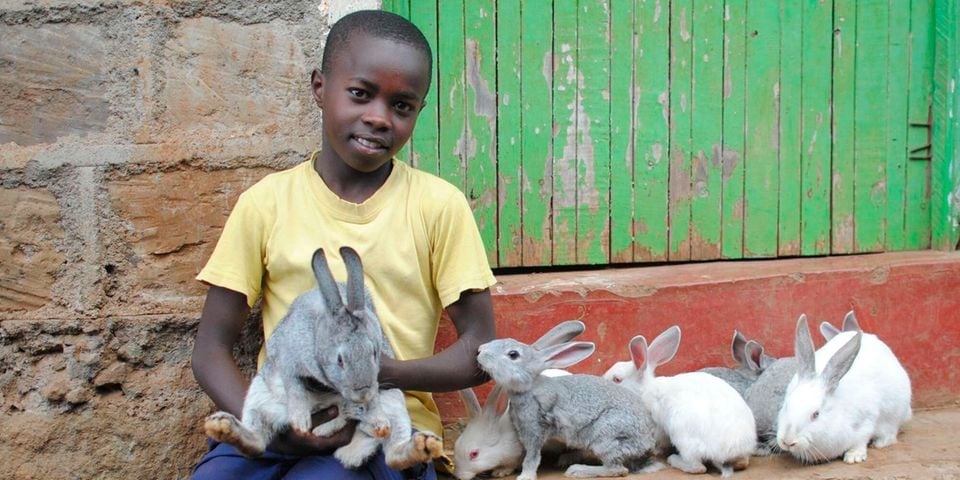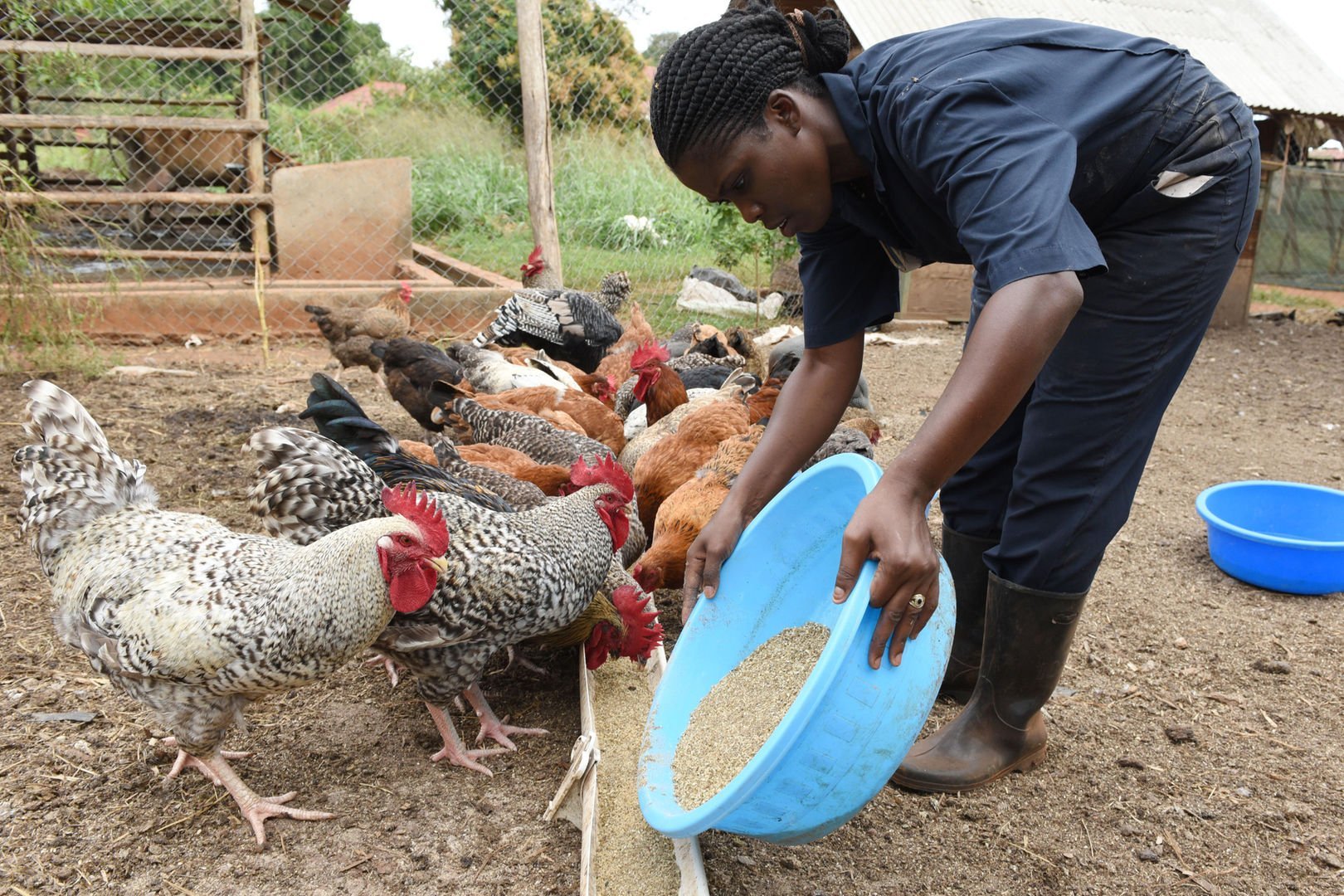Prime
How to control rabbit diseases

A farmer feeds rabbits on his farm. Photo | Michael J Ssali
What you need to know:
- Regular cleaning and replacement of bedding are essential. A litter box filled with paper-based or wood-based litter is also essential for hygiene and odor reduction. Enrichment items like toys, tunnels, hideouts, platforms, chew items, and foraging materials enrich the environment and stimulate natural behaviors.
Preventing rabbit diseases is paramount for their well-being. Maintain a clean, well-ventilated housing to prevent stress and infections, ensuring spaciousness and avoiding overcrowding.
Provide a balanced diet with fresh water, hay, and limited pellets to meet nutritional needs while avoiding sudden dietary changes. Shield rabbits from potential disease vectors like wild animals, rodents, and insects using fencing or cages.
Implement quarantine for new or sick rabbits, isolate them until proven healthy, and promptly consult a veterinarian for any signs of illness or injury. Vaccination against common viral diseases, such as myxomatosis and rabbit hemorrhagic disease, is crucial. Collaborate with your veterinarian for suitable vaccinations.
Regularly monitor rabbits for signs of disease, including changes in weight, lethargy, appetite loss, diarrhea, respiratory symptoms, or abnormal behavior.
Diet and nutrition
A healthy, balanced diet for rabbit care. Rabbits should primarily consume hay and fresh grass, which are rich in fiber and essential for their digestive health. They also need a small amount of fresh vegetables daily, such as leafy greens, carrots, and herbs, which provide vitamins, minerals, and antioxidants. Clean water should be available at all times, preferably in a bowl.
Rabbits should avoid high-calorie foods like fruits, cereals, bread, nuts, seeds, or dairy products, which can cause obesity, dental problems, and gastrointestinal disorders.
Commercial pellets or treats are also not recommended as they are low in fiber and high in calories.
A healthy diet can prevent common diseases such as dental disease, obesity, gastrointestinal stasis, urinary tract infections, kidney stones, and liver disease and improve their mood, behavior, and quality of life.
Housing
Rabbits require a spacious and comfortable enclosure that meets their physical and behavioral needs. The minimum size for a single rabbit is 12 square feet (1.1 square meters), but larger is always better. For multiple rabbits, more space is needed. The enclosure should have a solid floor covered with bedding, such as hay, straw, or shredded paper, providing cushioning, insulation, and nesting material.
Regular cleaning and replacement of bedding are essential. A litter box filled with paper-based or wood-based litter is also essential for hygiene and odor reduction. Enrichment items like toys, tunnels, hideouts, platforms, chew items, and foraging materials enrich the environment and stimulate natural behaviours.
These items provide mental stimulation, physical exercise, exploration, and play while preventing boredom, stress, and destructive behaviors.
A rabbit’s enclosure should be placed in a safe, quiet area away from sunlight, drafts, heat sources, loud noises, predators, and other pets.
Rabbits are sensitive to temperature changes and prefer a calm environment that doesn’t stress them out or disrupt their sleep cycle.
Common viral diseases
Myxomatosis is a deadly disease in domesticated rabbits caused by myxoma virus, poxvirus group. It causes mucinous skin lesions or edema of the head and other parts of the body.
Wild rabbits, such as cottontails and jackrabbits, are resistant to the virus but can transmit it to domesticated rabbits through mosquitoes, fleas, biting flies, or direct contact.
Myxomatosis is a severe conjunctivitis that rapidly worsens, causing listlessness, anorecticness, and fever.
In acute outbreaks, some rabbits may die within 48 hours.
Those that survive develop a rough coat, edematous eyelids, nose, lips, and ears, and a swollen head. In females, the vulva becomes inflamed, while males swell. A purulent nasal discharge and labored breathing can occur, and rabbits may go into a coma just before death.
Occasionally, fibrotic nodules may appear on the nose, ears, and forefeet. Rabbit fibroma virus causes benign skin tumors in domesticated and wild rabbits, which can interfere with vision, breathing, eating, or movement.
Bacterial infections
Bacterial infections common cause of illness and death in rabbits, affecting various parts of the body, such as the respiratory system, skin, reproductive organs, ears, and eyes.
Common bacteria infecting rabbits include Pasteurella multocida, Staphylococcus aureus, Streptococcus spp., Pseudomonas aeruginosa, Bordetella bronchiseptica, and Listeria monocytogenes.
Symptoms include fever, lethargy, loss of appetite, weight loss, dehydration, discharge from the nose, eyes, or ears, sneezing, coughing, difficulty breathing, abscesses, skin lesions, hair loss, itching, redness, swelling, pain, lameness, head tilt, loss of balance, seizures, and death.
Causes of bacterial infections in rabbits include poor hygiene, overcrowding, stress, weak immune system, trauma, wounds, bites, scratches, foreign bodies, dental problems, and parasites.
Treatment depends on the type and extent of the infection, and common treatments include antibiotics, fluid therapy, pain relief, anti-inflammatory drugs, surgery, wound cleaning and dressing, eye drops or ointments, and ear drops or ointments.
Parasitic problems
Ear mites are a common parasitic issue affecting rabbits, causing irritation, inflammation, and crusty discharge.
They can spread to other parts of the body, such as the face, neck, and feet. Diagnosis can be done through an otoscope examination or ear wax samples.
To prevent ear mites, keep rabbits’ ears clean and dry, avoid contact with infected rabbits, and use topical medications like ivermectin or selamectin to kill the mites and prevent re-infestation.
Regular cleaning of the rabbit’s cage and bedding is also essential. Coccidiosis is another common parasitic problem affecting rabbits, causing diarrhea, weight loss, dehydration, and death in severe cases.




